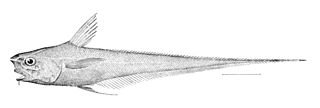
Grenadiers or rattails are generally large, brown to black gadiform marine fish of the subfamily Macrourinae, the largest subfamily of the family Macrouridae. Found at great depths from the Arctic to Antarctic, members of this subfamily are amongst the most abundant of the deep-sea fish.
The black ruff is a medusafish, the only member of the genus Centrolophus. It is a pelagic fish found in all tropical and temperate oceans at depths of 0 to 1,000 m. Its length is typically up to 60 cm (24 in), but it may reach 150 cm (60 in). Other common names include rudderfish and blackfish.

Coryphaenoides is a genus of rattails which is found in all oceans of the world. They are found in deep waters and C. yaquinae, recorded to 7,012 m (23,005 ft), is the only member in the family known from the hadal zone.

Hymenocephalus is a genus of rattails.

Coryphaenoides leptolepis, the ghostly grenadier, is a species of rattail found in the northern Atlantic and Pacific Oceans at depths of 610 to 4,000 metres. This species grows to a length of 62 centimetres (24 in) TL.

Trachyrincus scabrus, the roughsnout grenadier or Mediterranean longsnout grenadier, is a species of bathydemersal marine fish from the subfamily Trachyrincinae, part of the family Macrouridae. It is found in the eastern Atlantic Ocean and the Mediterranean.

The lesser amberjack, also known as the false amberjack or little amberjack, is a species of ray-finned fish from the family Carangidae, the jacks and pompanos.

Taractes rubescens, the pomfret, keeltail pomfret, knifetail pomfret or black pomfret, is a species of marine ray-finned fish, a pomfret of the family Bramidae. T. rubescens is closely related, and quite similar, to Taractes asper, but adults can most easily be distinguished by the bony keel present on the caudal peduncle. In fact, this bony keel is unique to Taractes rubescens and will distinguish it from all other bramids.
Coryphaenoides brevibarbis, also called the shortbeard grenadier, is a species of deep-sea fish in the family Macrouridae.
The spearsnouted grenadier is a species of fish in the family Macrouridae.

The morid cod, largeye lepidion, or North Atlantic codling is a species of fish in the family Moridae. The Catalog of Fishes considers it a synonym of Lepidion lepidion.

The hollowsnout grenadier, also called the blackspot grenadier, is a species of fish in the family Macrouridae.

The carapine grenadier is a species of deep-sea fish in the family Macrouridae.

The common Atlantic grenadier is a species of fish in the family Macrouridae.
The salmon smooth-head, also called the deepsea slickhead, is a species of fish in the family Alepocephalidae.
Paracetonurus flagellicauda is a species of fish in the subfamily Macrourinae. Some sources place it in the genus Pseudonezumia.

Günther's grenadier is a species of deep-sea fish in the family Macrouridae.

The bigeye rockling is a species of fish in the family Lotidae.

The Mediterranean grenadier is a species of deep-sea fish in the family Macrouridae.
The deepwater grenadier is a species of deep-sea fish in the family Macrouridae.















